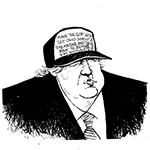Eric's Autos: 2025 Toyota 4Runner
Change can be good, bad -- or just scary. Toyota's 4Runner just got changed.
It's no longer available with the 4.0-liter V6 that used to come standard, but it now comes standard with a turbocharged four that's stronger than the previously standard V6 and uses less gas. It also comes standard with a 6,000-pound tow rating; that's 1,000 pounds higher than the previous V6 4Runner's max. There's a new optional engine too -- something the 4Runner didn't used to offer -- and it's by far the strongest engine yet offered in this popular SUV.
So what's scary about that?
Mostly, the future -- which is unknowable until we get there. Whereas we know the past was very good.
What It Is
The 4Runner is a midsize, body-on-frame SUV (not a crossover) closely related to the Tacoma pickup. In fact, the 4Runner can accurately be described as a Tacoma with its bed enclosed; it is designed to carry as many as seven people in up to three rows; the Taco has just two rows and a bed -- for carrying stuff rather than people.
Base price -- for the two-wheel-drive SR5 trim -- is $41,270; adding the optional four-wheel-drive system bumps the price tag up to $43,270.
There are also multiple TRD variations, beginning with the $47,750 TRD Sport, which gets 20-inch wheels, heated seats and a fully digital main gauge panel. Adding 4WD bumps up the MSRP to $49,750. The TRD Off Road -- $49,690 -- features 18-inch wheels with all-terrain tires, Bilstein shocks, underbody skid plates and multi-terrain/Crawl Control driving modes.
4WD is standard.
There are also TRD Sport Premium ($53,110) and TRD Off Road Premium ($55,470) trims that add various luxury amenities, including a 14-speaker JBL audio system, synthetic leather upholstery, a portable Bluetooth speaker and hands-free liftgate.
Topping the lineup are the Trailhunter and TRD Pro trims -- both stickering for $67,400. Both come standard with 4WD and additional off-road equipment, including a disconnecting front sway bar (to allow for greater independent wheel articulation), high-mount air snorkel (to protect against water being sucked into the engine while fording creeks and so on), wider fender flares, fog lights and auxiliary equipment switches prewired. The Trailhunter comes with bronze-finished wheels, frame-mounted rock sliders, Emu off-road shocks, an ARB roof rack and a built-in air compressor.
What's New for 2025
The 4Runner gets a major makeover for the new model year. In addition to the new standard and optional drivetrains, the '25 4Runner features a revised interior with updated tech features, including available voice control for some of the vehicles functions.
The exterior also gets tweaked, but you have to look closely to see the changes here.
What's Good
-- Body-on-frame construction (which makes this SUV tough and harder to hurt as well as less expensive to repair; more about this follows) hasn't been changed.
-- New standard turbo four makes more horsepower and a lot more torque than the previously standard V6; optional turbo-hybrid four makes even more.
-- 4Runner's rugged good looks have not been retained.
What's Not So Good
-- New turbo fours are an unknown factor; they may prove to be as durable and reliable as the reliable and durable V6 you can't get anymore. But only time will tell.
-- You can't get the optional third row with the turbo-hybrid four; probably because the hybrid part of the drivetrain uses up the space back there.
-- Too many menus/inputs on the screen. A simple left-right tuning knob to change radio stations would have been better.
Under the Hood
For the past 14 years, the 4Runner came standard with Toyota's well-regarded 4.0-liter V6. It is well regarded because of its long-established track record. It has proved to be the kind of long-haul engine many people want because an engine that goes 250,000 miles or more before it needs major repairs means being able to drive the vehicle it's in for as long as it takes to rack up a quarter-million-plus miles, which is typically 15-20 years or even longer than that.
The good news is the new 2.4-liter four is stronger than the old 4.0-liter V6, which made 270 horsepower and 278 foot-pounds of torque. On boost, the much smaller four summons 278 horsepower and 317 foot-pounds of torque, enough to bump up the '25 4Runner's standard towing capacity to 6,000 pounds (up from 5,000 pounds previously). There is also a significant uptick in gas mileage.
There's more too. For the first time, the 4Runner is available with an optional engine. It is a turbo-hybrid drivetrain that touts 326 horsepower and 465 foot-pounds of torque. Both of those are good numbers for a V8 twice the physical size of the 2.4-liter four. Impressively, the huge increase in power does not come standard with lower gas mileage. Equipped with the turbo-hybrid setup, a 4Runner touts 23 mpg city, 24 mpg highway.
With either engine, an eight-speed automatic is the standard transmission.
On the Road
Despite the loss of almost half its engine, the 4Runner hasn't lost a step. Equipped with the now-standard 2.4-liter turbo engine, 0-60 mph takes about the same 7.4 seconds. But you go farther between fill-ups. The '25 4Runner with the 2.4-liter turbo engine can take you 361 miles in city driving and 475 miles on the highway; last year's V6-powered 4Runner went 368 miles in the city and 437 miles on the highway. That difference is more than it appears too -- because the '25 4Runner has a smaller (19-gallon) tank versus the 23-gallon tank that last year's 4Runner had. If Toyota had kept the tank size the same for 2025, the new 4Runner would have been able to take you almost 100 miles farther. It's shame Toyota didn't keep the tank size the same, for just exactly that reason.
It is also the right size for actually going off-roading. It's not too wide (important when threading the needle on a narrow trail with trees and little room to spare on either side), and on the road, you don't feel as though you're driving a kind of 4WD Queen Mary.
At the Curb
It doesn't look like much has changed. The changes to the exterior are slight, which is good because why change what people obviously like?
Mild tweaks to the front and rear ends. Nothing to fix what ain't broke. Rugged -- but not cod piece macho. Functionally rugged. The headlights don't protrude and so are less vulnerable to being damaged. The grill is not a huge catfish mouth with a massive (and fragile) plastic grille. It's also recessed so, again, less likely to be broken by just slightly bumping into something. Lots of clearance in the wheelwells -- so the tires are less likely to scrub when you hit a big dip. Molded-in fender flares to help control the mud splash. Good visibility in every direction other than the rear -- if you have the optional third row, because the headrests block about 10% of the view on either side. These can, however, be easily removed, and if you haven't got the third row, it's no problem to begin with.
As mentioned earlier, the just-right size of the 4Runner is very appealing if you're someone who needs something that's not too small but doesn't want something that's too big. There's ample room for four; enough room for five and room for seven if two of them are kids or young teenagers.
The Rest
Once again, there's this weird upselling of the hybrid drivetrain, which is only available with the Limited, Platinum, TRD Pro and Trailhunter trims. This means the least expensive version of the 4Runner with the hybrid drivetrain is the $52,490 TRD Pro. That's an $11,220 bump to get the hybrid drivetrain.
The Bottom Line
On paper, the new 4Runner is stronger than ever. Whether it is better is something we won't know until the future plays out -- and that'll take some time.
========
Eric's latest book, "Doomed: Good Cars Gone Wrong!" will be available soon. To find out more about Eric and read his past columns, please visit the Creators Syndicate webpage at www.creators.com.
Copyright 2025 Creators Syndicate, Inc.








Comments